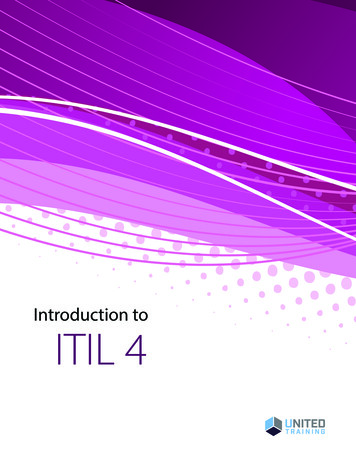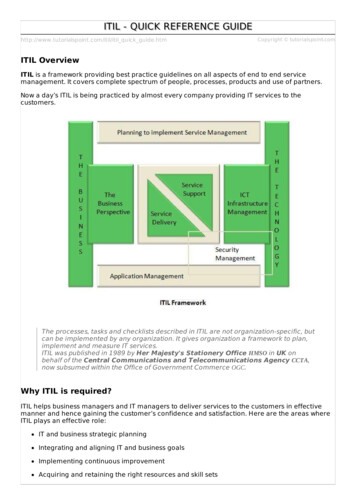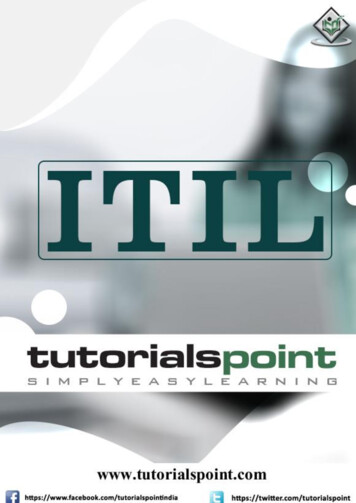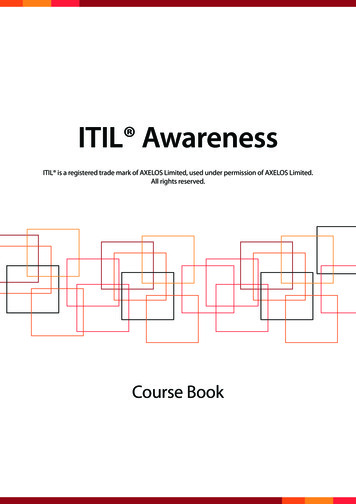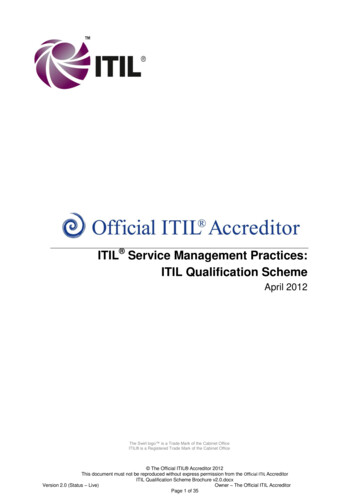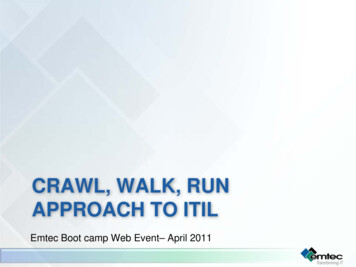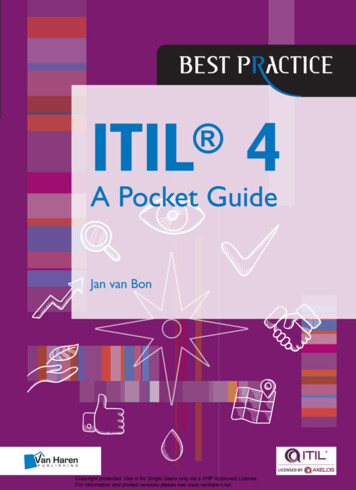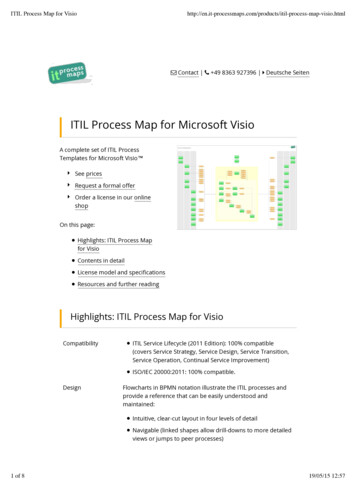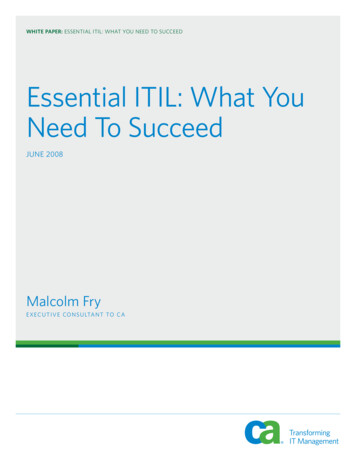
Transcription
WHITE PAPER: ESSENTIAL ITIL: WHAT YOU NEED TO SUCCEEDEssential ITIL: What YouNeed To SucceedJUNE 2008Malcolm FryE X EC U T I V E CO N S U LTA N T TO CA
Table of ContentsSECTION 11IntroductionSECTION 22ITSM Meets PerfumeryTypes of ScentsThe ITIL EssentialsSECTION 34The Eight Essential ElementsSECTION 46What Makes the “Essentials” Essential?Getting the Basics RightSECTION 57Real World Application of “The Essentials”SECTION 6: CONCLUSION8SECTION 6: ABOUT THE AUTHOR9Copyright 2008 CA. All rights reserved. All trademarks, trade names, service marks and logos referenced herein belong to their respective companies. This document is for your informational purposes only. To the extent permittedby applicable law, CA provides this document “As Is” without warranty of any kind, including, without limitation, any implied warranties of merchantability or fitness for a particular purpose, or noninfringement. In no event will CA beliable for any loss or damage, direct or indirect, from the use of this document, including, without limitation, lost profits, business interruption, goodwill or lost data, even if CA is expressly advised of such damages. ITIL is a RegisteredTrade Mark of the Office of Government Commerce in the United Kingdom and other countries.
SECTION 1IntroductionJudging from the types of questions that come up at my talks and seminars, one of the hottesttopics in IT Service Management (ITSM) today is the new ITIL v3 guidance and what to makeof it.People consistently ask me similar questions about ITIL, and most of these revolve aroundpractical approaches for implementing various process improvements in their organization.Of course, some of these discussions require some basic level-setting around ITIL itself, whichmay in turn require a bit of “de-myth-tification.” Since its introduction back in the 1980s, ITILhas probably had more written about it than is contained in the ITIL books themselves — someof it factual, some hype, and some pure myth.So let’s start there: what is ITIL really all about?First, ITIL is about people. In fact, ITIL starts with a commitment to the people of IT, because itconsists of a series of individual IT practitioner certifications. These certifications help improvethe skills required to deliver high quality, repeatable, and well-controlled IT services. There is no“company-wide ITIL certification” — these would, in fact, be handled by the internationalstandards organization ISO via ISO 9001/8 and 20000 corporate certifications.Second, ITIL is about process. There are different approaches to process implementation basedon which “version” of ITIL you are inclined to adopt. But without debating the merits of ITIL“versions,” let us presume that any ITIL implementation discussion ultimately has roots in theprinciple of Process Improvement. Besides, ITIL v2 and v3 are more alike than different at afundamental level. Both embody essential ITSM processes that every IT organization mustperform to the best of its ability – you’re doing them as a matter of course whether you haveefficient processes in place, or not. Thus almost any question you might ask about ITIL comesdown to this: how do you best make use of whatever essential ITIL v2 and/or v3 elementsmake sense for you to adopt given your specific needs.Third, ITIL has starting points. This is one of the most widely discussed topics as of late,especially as ITIL isn’t considered to be highly prescriptive. Rather, it's a set of “good practice”guidance for IT practitioners to follow. They may adhere to these strictly, as outlined in each ofthe books. Or, more likely, practitioners may adapt the ITIL guidance as they see fit based onthe unique skill sets, goals, and functions of their unique IT organization.But rest assured, there are a handful of ITIL processes which are essential to today’s ITorganizations and the services they deliver – whatever the specifics of the organization happento be. This last point is worth expanding upon further, which I’ll do by way of an analogy.WHITE PAPER: ESSENTIAL ITIL: WHAT YOU NEED TO SUCCEED 1
SECTION 2ITSM Meets PerfumeryWhen I first looked at the large number of processes and functions in ITIL v3 my initial reactionwas perplexity: Where do I start and how should I decide an approach? When I have thisdilemma I often find it valuable to look to other industries for a long-established precedent, andsee if I can learn from their experiences. Right about this time my wife had decided to changeher perfume, and there was the inspiration I needed — in the ancient art of perfumery.Imagine being given the task of creating a new and exciting perfume. Just think of all thepotential ingredients and the sheer complexity of the task. Selecting and synthesizing a fewcomponents from among many is a challenge perfumers have grappled with for thousands ofyears as they’ve sought to blend exquisite scents from a myriad of available ingredients. This issimilar to the problem we face in talking about what processes are essential in ITSM, andhence in ITIL.To achieve success, perfumers have structured a logical approach that, through analogy, can beapplied with good effect to determining what’s essential to implement in ITIL v2 and/or v3.Of course, the ingredients you ultimately choose will be driven by the specific problem you’retrying to solve. Are you being asked to create the ITSM equivalent of a chewing gum flavor,versus a captivating cologne? The collection of ITIL processes you choose to implement willreflect that, as I’ll explain shortly.Types of ScentsPerfumes basically consist of four classes of ingredients: primary scents, modifiers, blenders,and fixatives.scents can consist of one or a few main ingredients that create a classic, naturaltheme or concept, such as “rose” or “jasmine.” Alternatively, multiple ingredients used togethercan create an “abstract” primary scent that doesn’t directly resemble a natural ingredient, suchas “cola.” These become the essential elements around which the perfume will be based, andare key to a successful perfume. Of course, before selecting the primary scents you would needto have some guidance; for example, is the scent for a man or a woman, young or old, rich orpoor, trendy or staid? From this basic data the process can begin.PRIMARYalter the primary scent to give the perfume a distinct, desired character. Forexample, fruit esters can be included with a floral primary scent to create a “fruity floral” scent;whereas citrus scents specifically create a “fresher floral.” The cherry scent in cherry cola is thiskind of modifier. If we only used the primary scents then we would have much less choice, butthe skill of the master perfumer is in the subtle addition of modifiers that create a new andexciting combination.MODIFIERSBLENDERS are a diverse group of ingredients that smooth out or “round off” the transitionalnotes of a perfume by blending, balancing and harmonizing its different “layers” or “bases;” i.e.,the primary scents and modifiers. Common blending ingredients include hydroxycitronellal,which imparts a floral odor to numerous consumer products, and linalool, a naturally occurringterpene alcohol found in many flowers and spice plants.2 WHITE PAPER: ESSENTIAL ITIL: WHAT YOU NEED TO SUCCEED
are used to support the primary scent by bolstering and stabilizing it. Resins andwood scents, and amber bases, are among the scents typically used for fixative purposes.Without these components smells can break apart and just not work, like immiscible liquids.FIXATIVESGranted that’s all vastly oversimplified but you get the picture: in a perfume some scents areprimary and others play secondary or supporting roles. It’s the same with the ITIL processes asI’ll now explain.The ITIL EssentialsTalking about individual ITIL processes in isolation from one another is inherently limiting,especially in the ITIL v3 context, since the processes are designed to be used together. Butwhich ones are essential and which are optional? The component approach and associatedterminology used in perfumery is an ideal way to illustrate the relationships among theessential elements and how they work together with supporting processes.are those essentials that every IT organization must have, and inherently doeshave, whether it embraces the ITIL guidance or not. Every IT shop has some way of managingincidents, for example, even if it’s just assigning someone to fix what breaks in response tocomplaints from users.ITIL PRIMARIESITIL MODIFIERS such as Service Level Management and Service Catalog, are those processesthat “flavor” the character of the primary processes. In relation to the essential process ofIncident Management, for instance, these “modifiers” determine whose incidents are moreimportant than someone else’s. Part of setting up a service catalog would be to decide thatwhen System X fails it’s a Priority 1 call whereas when System Y fails it’s a Priority 3 call. Mostorganizations will need to implement some version of these Modifiers as they will thePrimaries. You don’t want people making up their own priorities and escalations — you wantrules, and those rules modify the behavior that is required on a primary level.are those processes that ensure everything will work together. For example,Capacity Management ensures you have enough staff, servers, etc. to execute the otherprocesses.ITIL BLENDERSITIL FIXATIVES in this case are Financial Management activities; things like headcount andbudget that bond the whole IT infrastructure and organization together in the end. That is, withwhatever your budget and governance are, you make sure you’ve got the best possible facilitiesto meet business needs.WHITE PAPER: ESSENTIAL ITIL: WHAT YOU NEED TO SUCCEED 3
FIGURE AITIL v3 FUNCTIONS & PROCESSESFunctions and Processes from theService Lifecycle as listed in the fivecore publications describing the ITService Management practices thatmake up ITIL v3.Just for fun, try this exercise: Create a simple spreadsheet with four columns, one for each ofthe four constituents just described, and then start putting the names of each v3 process orfunction in Figure A into whichever one of the columns you think it belongs under. It’s a veryinteresting exercise because everyone looks at the various processes and their interrelationshipswith a different set of eyes. If you do this as a group you may get into a lively discussion.SECTION 3The Eight Essential ElementsAs stated above, some ITIL processes are essential to every IT organization — because you’redoing them regardless of whether you have an efficient process in place to help you or not.Let’s take stock now of the essential ITIL processes and why they’re essential to IT ServiceManagement success.If you compare the bullet list that follows to the list of ITIL v3 functions and processes in FigureA you’ll quickly see that, while it’s obvious that some of these processes are clearly essential toITSM, it is difficult to decide exactly which processes and functions to include because thereare many sub-processes in v3. Figure A illustrates the large range of elements that need to beaddressed from the v3 perspective.4 WHITE PAPER: ESSENTIAL ITIL: WHAT YOU NEED TO SUCCEED
Leveraging the collective ITIL guidance with an eye toward “first steps” and foundationalaspects, here are the eight essential ITSM processes that are required by all IT departments:1.Service Desk2.Event Management3.Problem Management4.Service Asset & Configuration Management5.Change Management6.Incident Management7.Request Fulfillment8.Release & Deployment ManagementRecent research supports calling these processes out as essential. For example, the IT ProcessInstitute, in its research on Identifying Key Performance Drivers1, found seven sets of controlpractices that predict top levels of performance. From highest to lowest impact, they are: Release scheduling and rollback (Release & Deployment Management) Process culture Pre-release testing (Change Management) Process exception management (Incident Management and Problem Management) Standardized configuration strategy (Service Asset & Configuration Management) Change linkage (Change Management) Controlled production accessLooking at these control practices you can see that most of them map closely to five of the ITILessentials. Process culture is a management initiative and not an ITIL element per se, andtherefore is not covered by the essential elements. This leaves Controlled Production Access,which the essential ITIL processes will contribute by highlighting and supporting resolution ofvarious security issues, as well as ensuring that new services are secure.Similarly, the eight ITIL essentials encompass much of what is in the ITIL Service Transition andService Operation phases, which have been well-quantified in terms of their impact to ITperformance.WHITE PAPER: ESSENTIAL ITIL: WHAT YOU NEED TO SUCCEED 5
SECTION 4What Makes the “Essentials” Essential?Now let’s briefly discuss each of the eight essential ITIL processes individually, with an eyetoward why each is so important.SERVICE DESK Everybody using computers everywhere at some point needs something fixed.Even if a business doesn’t have a Service Desk per se the activity is still happening — peopleinevitably call or e-mail someone or knock on someone’s door and say “this doesn’t work, fixit.” Service Desk is thus a basic IT activity irrespective of whether you formalize it withtechnology and skilled people or not; calling the Geek Squad or another third party amountsto the same thing.An Event is a set of circumstances that may or may not affect thecustomer, but you know it has happened or you can predict that it shortly will happen; e.g., yousee that a particular server is getting near its capacity limit. So hopefully you spot that as anEvent, you tell Capacity Management, and they create more capacity. The customer doesn’teven know the server they use nearly froze. Event Management is being done all the time, anytime threshold/alerts are established or IT is monitoring the infrastructure.EVENT MANAGEMENTIncident Management is all aboutgetting the customer’s service back to agreed service levels as fast as possible. Again, this is anessential ingredient because keeping the business performing to its maximum performancelevel is why ITSM exists. And Problem Management is about root cause analysis relative toIncidents. Problem Management asks “Why did that incident or group of incidents occur? Andwhat can we do to stop that happening again?” Again, that’s an essential part of how you doyour job in IT.INCIDENT MANAGEMENT AND PROBLEM MANAGEMENTIT changes constantly. There isn’t any shop that isn’t changing on adaily basis, be it major or minor in magnitude. You have to perform changes all the time to fixEvents, respond to Problem Management insights, roll out new equipment, and so on. ChangeManagement is not only essential to IT operations, but it’s also your Achilles’ heel. The recentthree-hour e-mail outage that BlackBerry users experienced, which resulted from an upgrade toincrease capacity, is but one example among many of the high-magnitude risks associated withfailed changes.CHANGE MANAGEMENTREQUEST FULFILLMENT Employees, customers and other stakeholders inevitably have requestsrelating to services in whatever form; and, of course, you have to address those requests to thebest of your ability or what are you there for? You must do that; it’s a basic part of your job.RELEASE & DEPLOYMENT MANAGEMENT Some might view this process as subsumed underChange Management but either way the activities associated with it are essential. Say you’vegot a brand new payroll system going live. This includes everything associated with getting thatbusiness-critical service in place; conducting the related training; moving, converting, andbacking up files; and so forth. Another example might be rolling out two hundred newworkstations over the weekend. Again, Release & Deployment Management is the kind ofservice IT is providing all the time with varying levels of efficiency and effectiveness.6 WHITE PAPER: ESSENTIAL ITIL: WHAT YOU NEED TO SUCCEED
SERVICE ASSET & CONFIGURATION MANAGEMENT This essential process is squarely where ITgovernance comes to the forefront. Every IT department needs to know what assets it has,where they are located and what is being done with them. If you don’t know this assetinformation than you are probably violating Sarbanes-Oxley since they want to know why youdon’t know. So inarguably this process, too, is essential.Getting the Basics RightThese essential elements figure prominently in both ITIL v2 and v3, but in v3 the guidancearound them has been upgraded. For this reason I recommend that organizations that haveembraced v2 (as well as those that have yet to do so) at least consider upgrading theiressential elements to incorporate v3 enhancements.That said, it remains absolutely imperative for every IT shop to get the basics right at whateverlevel is currently possible. Implement these essential elements first, in whatever order makessense for your IT organization, leveraging ITIL advice wherever possible. If you’re working withthe service lifecycle approach in v3 then you’ll be modifying and blending the essentials withsome of the supporting processes at the same time. Even from a v2 perspective, in fact, you’llbe doing some blending, shading, and customization of the essentials to fit your needs.It is important to remember also that, wherever you start out from, you will still need to“continuously improve” by adding the other layers – especially the Modifying layer, whichincludes elements such as Service Level Management and Service Catalog.SECTION 5Real World Application of “The Essentials”Let’s now apply all this emphasis on the flexible application of essential ITIL processes toanswering the kinds of questions I hear every day from IT managers and leaders alike.My boss told me to forget about strategy and to concentrate on improving service management —how do I do this with ITIL v3?One approach would be to implement the essential elements to a given maturity level; and,once those are in place then go back to the boss and say, “OK, we’ve got control of our basicprocesses, now let’s do ITIL v3 the proper way using the service lifecycle approach.” That is,look at the essentials versus your current practices and determine how far from the v3guidelines you are for each one. Then ask: What do we need to do to close the gap? Havingimplemented the essentials you’ve lost nothing towards moving ahead with the serviceoriented methodology that v3 advocates.To prove the business value of ITIL v3 to my boss and peers I need some quick wins — how do I dothis with v3?It’s often the case that senior IT managers don’t have direct, hands-on experience with ITIL;hence they might legitimately question whether it’s just another way for consultants to makemoney. If this is your situation my advice would be similar to the above: look at your basicprocesses today, pick the ones you’re worst at right now, and improve them using v3 guidanceto a basic level of maturity that provides business value. Then you’ll have some leverage tojustify your case to move forward with the lifecycle approach.WHITE PAPER: ESSENTIAL ITIL: WHAT YOU NEED TO SUCCEED 7
I am not interested in the service lifecycle approach, so can I still use ITIL v3?Some organizations just don’t “do” long-term planning, but that doesn’t mean you can’t makegood use of ITIL v3. First get the essential elements in place, then look at the rest of thecomponents and start integrating supporting processes with those basic eight, keeping in mindthe perfume analogy above. First modify the basics, then add blenders and fixatives as I’vediscussed.How can I build a good set of essential elements from ITIL v3?Select the processes that address your greatest pain points, perform a process gap analysisand then close the gaps. But keep in mind that the number of “essential” processes youultimately put in place might be more than the eight discussed here. When you take a closerlook at v3 guidance (likewise see Figure 1) you’ll see that there aren’t just a few processes andfunctions involved, there are more than thirty of them. Once you’ve got the basics in placeyou’ll want to continue on and build in others – even if you don’t plan to adopt v3’s servicelifecycle approach. It’s reasonable to take the v2 approach to process implementation since v2is process-oriented. But adopt the v3 guidance about what constitutes a process, its inputs andoutputs, etc., and then prioritize your rollouts of specific processes based on what you need toimprove most.SECTION 6ConclusionITIL isn’t about the debate over Versions or Processes or Lifecycles. As my colleague RobStroud notes in his blog titled: ITIL v3 — You’re doing it whether you know it or not, if youwant to work for successful organizations, they have probably already put several aspects ofITIL v3 into practice — whether they realize it or not. As the head of the ITSM team at a largemanufacturer commented, "any ITIL implementation that is service aligned is doing muchof v3 already."The keys to success then, are the eight essential elements that every IT organization shouldadopt and perform to the best of its ability.When practical considerations preclude adopting all aspects of the v3 methodology, thisshould be seen as a valid starting point, not a stumbling block, for leveraging the essentialelements. Once basic processes are in place organizations can begin to fine-tune and expandon those processes by adding “modifiers,” “blenders” and “fixatives” — supporting processesthat “flavor” the IT environment in line with unique, local requirements.8 WHITE PAPER: ESSENTIAL ITIL: WHAT YOU NEED TO SUCCEED
SECTION 7About the AuthorMalcolm FryIndustry Personality and AuthorExecutive Consultant to CAMalcolm Fry began his IT career in 1967, and in the following years took on development,operational and management roles for retail, manufacturing, oil, and pharmaceuticalorganizations. He has received worldwide recognition as one of the foremost authorities inthe areas of help desk and IT service management. He is the author of numerous best-sellingbooks on IT service and support, the newest being Building an ITIL Service ManagementDepartment which is due to be published in May. In addition he has had many articles andpapers published in multiple languages, and is currently writing a white paper for CA extollingthe importance of the Essential ITIL V3 Processes and Functions. Malcolm was also a memberof the ITIL Advisory Group (AIG) steering ITIL v3 and a mentor, along with Rob Stroud, to theauthors of the ITIL v3 Service Transition book.Malcolm is an innovative and informative strategic consultant sought-after by many largeorganizations that see him as a catalyst to initiate improvements by reviewing their facilitiesand processes, and most importantly, preparing plans to allow them to meet their businessand IT objectives. He is also a regularly featured keynote speaker at Service Managementconferences around the world.WHITE PAPER: ESSENTIAL ITIL: WHAT YOU NEED TO SUCCEED 9
CA (NSD: CA), one of the world's leading independent,enterprise management software companies, unifies andsimplifies complex information technology (IT) managementacross the enterprise for greater business results. With ourEnterprise IT Management vision, solutions and expertise,we help customers effectively govern, manage and secure IT.MP329560608
WHITE PAPER:ESSENTIAL ITIL: WHAT YOU NEED TO SUCCEED Essential ITIL: What You Need To Succeed JUNE 2008 Malcolm Fry EXECUTIVE CONSULTANT TO CA. Table of Contents SECTION 1 1 Introduction . the books. Or, more likely, practitioners may adapt the ITIL guidance as they see fit based on the unique skill sets, goals, and functions of their unique .


